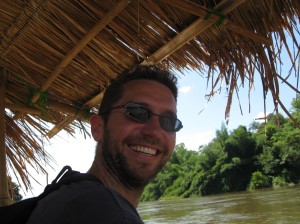I’ve heard Bangkok referred to as an assault on the senses, but after 2 days in Cambodia’s capital, I would have to say this classes as a full scale attack with noise, smells and images unlike no other. At first sight you may think it a typical Asian city, lots of street markets, food carts, motorbikes, push bikes, lots of horns beeping and Tuk-Tuk’s as far as the eye can see. But when you look a little closer you see the differences.
The roads are the first giveaway. There may well be road markings, but these are blatantly ignored and all you can do is maintain your speed with white knuckles, sharp intakes of breathe and the occasional high pitch squeal, (from my female passenger of course). Your fellow commuters are inventive to say the least and have a good grasp of the benefits of car sharing. One van, 4 rows of seats, every row has 4 people on the seat and 4 people on their laps, even the driver was sitting on someone’s lap with 1 person wedged between them and the driver’s door, not to mention the 12 people holding on to the roof rack – economic and environmental!
Then there are the vehicles on the road, this fascinated me more than anything else. The people of Cambodia know the true meaning of car pooling. My favorite memory of this was a van with 4 rows of seats and every row had at least 4 people across and someone else sitting in their laps. Even the driver was sitting in someone’s lap, with another person between them and the drivers door. And it didn’t stop there, on the roof there was a further 12 people holding onto the roof rack.
What I really enjoyed was the people. So friendly, approachable and with beautiful smiles. Drivers shouting ‘tuk tuk?’ suggestively and the comedic ‘One dollar? Maybe laytur?’ when trying to induce you to buy some trinket or food. Then they remembered you the next day, pressing free flowers in to your palms to say ‘thank you’ for the bracelet you bought the day before.
But the city of contrasts also also offers an interesting yet extremely sad insight into Cambodia’s recent and tragic past. Only 30 years ago, Cambodia was under the control of a regime that left a horrific legacy for its people that is still evident with many of its people today. The Khmer Rouge came into power in 1975 under their Leader Pol Pot, and commenced a radical form of communism which lead to the deaths of 2 million of Cambodia’s own people, through torture, execution, forced labour and starvation. The Toul Seng museum or S21, is the site of one of the main prisons which is now a museum to the memory of the people and the events of this era.
There is another key part to understanding the Khmer Rouge regime and that is a visit to the Killing Fields. The Killing Fields has little remaining evidence of the events that occurred there as most parts of now been removed, however, there is a commemorative Stupa to the people which is a tower like building containing the skulls and bones of the many discovered human remains at the site. If you are traveling to Phnom Penh these are both worth a visit, but do Toul Seng first, as many of the images you see at the museum, you will be able to translate into reality in at the Killing Fields.




One Comment
good article